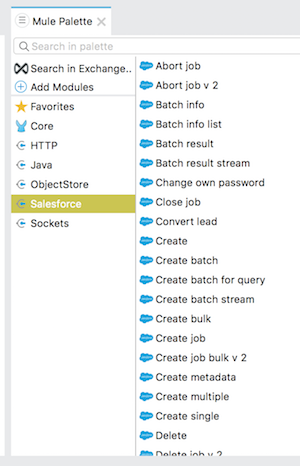
Mule Applications
|
Standard Support for Mule 4.1 ended on November 2, 2020, and this version of Mule reached its End of Life on November 2, 2022, when Extended Support ended. Deployments of new applications to CloudHub that use this version of Mule are no longer allowed. Only in-place updates to applications are permitted. MuleSoft recommends that you upgrade to the latest version of Mule 4 that is in Standard Support so that your applications run with the latest fixes and security enhancements. |
You typically create Mule apps to perform system integrations. Mule apps are configured to run in Mule Runtime. A request to a Mule app triggers Mule to encode the request and data in a Mule Event, and to pass it to either single or multiple threads.
The main building blocks of Mule apps are components. Components execute business logic on the messages that flow through your apps. There are three categories of component: core components, components that are grouped into collections named connectors, and components that are grouped into collections named modules.
Core Components
These are individual components that are part of the core of the functionality of Mule Runtime. Here is a sampling of the features that core components let you add to your apps:
-
Asynchronous processing of parts of a flow or subflow
-
Batch processing of messages
-
Initiating subflows
-
Logging
-
Setting payloads
-
Transforming messages with the DataWeave language
-
Creating Try scopes in your flows so that you can catch and respond to errors
For example, the Choice router is a component that dynamically routes messages through a flow according to a set of DataWeave expressions that evaluate message content. Each expression is associated with a different routing option. The effect is to add conditional processing to a flow, similar to an if/then/else code block in most programming languages.

For component documentation, see Core Components.
Connectors
Connectors group together components that were created to facilitate the integration of MuleSoft applications with any external resources, such as third-party APIs or standard integration protocols. They enable connectivity to SaaS and on-premises applications, systems, and services.
For example, the Salesforce Connector provides components that let you use the Salesforce platform APIs to perform a large number of different operations.

For connector documentation, see Connectors and Modules (for Mule 4).
Modules
Modules group together components that were created to add flexibility to your apps by allowing you to aggregate values compress data, use Java features, use extra features for processing JSON, and more. The features that modules offer are more at the level of traditional application coding.
For example, the XML module provides components that can process and extract data from an XML document.

Mule Configuration File for Applications
Mule apps are defined in a Mule Configuration File. This file is an XML document that specifies dependencies needed to run the app. In this configuration file, you can write the XML by hand.
You can also use the graphical user interfaces in Design Center or Anypoint Studio to structure and define the behavior of your Mule app. While you use either of these GUIs, the underlying XML is provided for you.
In Studio, the XML is also available for viewing and editing.
For module documentation, see Connectors and Modules (for Mule 4).



